Students get through the MP Board Class 11th Biology Important Questions Chapter 5 Morphology of Flowering Plants which are most likely to be asked in the exam.
MP Board Class 11th Biology Important Questions Chapter 5 Morphology of Flowering Plants
Morphology of Flowering Plants Class 11 Important Questions Very Short Answer Type
Question 1.
What are respiratory roots?
Answer:
There is lack of air in saline swampy areas. Roots of the plants grows in such areas grows vertically upward and comes out of the ground, which bears lenticels (some pores) called as pneumatophores through which gaseous exchange occurs during respiration e.g., Rhizophora.
Question 2.
From which part of seed, root develops?
Answer:
Root develops from radicle.
![]()
Question 3.
What is mycorrhizal root?
Answer:
These roots are commonly found in gymnosperms. In this root the portion of tap Toot and its branches becomes closely invested by the hyphae of a fungus. These fungal hyphae develop a close mat around the external surface of the root, and root hairs are absent e.g., Pinus.
Question 4.
What is taproot?
Answer:
The root which develops from the radicle and form main root. The lateral branches arising from the tap root or main root are termed as secondary roots. This root goes deep into the soil. It is characteristic of most of dicots, e.g., Mustard.
Question 5.
What is adventitious root?
Answer:
A root arising from any part of the plant other than radicle such as from stem or nodes is called as adventitious root. These roots are present just below the soil and they are present in group.
Question 6.
Write the name of two rootless plants.
Answer:
Wolffia and Utricularia are the two rootless plants.
Question 7.
Cuscuta plant do not bear leaves, how does they obtain their food?
Answer:
Cuscuta (Amarbel) is a parasitic plant. The stem and branches of this plant possessing specialized parasitic roots called as sucking or haustorial roots, through which they absorb food from host plant.
Question 8.
Write the two main characters of root.
Answer:
- Roots are usually positively geotropic, hydrotropic and negatively phototropic.
- The tip of a root usually covered by a small conical root cap, which protects root tip.
Question 9.
How do roots transfer water and minerals to various parts of the plant?
Answer:
Root hair zone of the root helps in transfer of water and minerals to various parts of the plant.
![]()
Question 10.
What is root cap? Write its importance.
Answer:
Root cap :
It is cap like parenchymatous multicellular structure which covers the root meristem. The cells of the root cap secrete mucilage. The latter lubricates the passage of root through the soil. Cells of root cap also possess starch grains. Meristematic tissue known as calyptrogen, help in the formation of root cap.
Question 11.
Write the name of root which helps in photosynthesis.
Answer:
Assimilatory root, e.g., Tenosporea, Trapa.
Question 12.
What are lateral roots?
Answer:
Lateral roots are endogenous in origin. Lateral roots arise from pericycle.
Question 13.
What are buttress roots?
Answer:
Buttress roots are the roots found around the base of stem and are formed by the branches of main root in which primary growth is unsymmetrical. These look like extra walls built to support any fort’s wall, e.g., Ficus.
Question 14.
Give examples of Napiform root and Conical root.
Answer:
- Napiform root: e.g., Turnip, beet root.
- Conical root: e.g., Carrot.
Question 15.
Stem develops from which part of the plant?
Answer:
Stem develops from plumule of seed of the plant.
Question 16.
Write the names of subaerial modification of stem.
Answer:
- Runner,
- Stolon,
- Offset,
- Sucker.
![]()
Question 17.
Distinguish between stolon and runner.
Answer:
- Stolon is a slender lateral branch that arises from the base of the main axis which afterwards grow above soil whereas runner is growing horizontally above ground.
- Stolon is relatively thick whereas runner is thin.
Question 18.
Write the difference between vascular bundle of root and stem.
Answer:
The vascular bundle of root is radial and exarch and in stem vascular bundles are conjoint, collateral and endarch.
Question 19.
What is cladode?
Answer:
These are green stems branches of limited growth which have taken over the function of photosynthesis from the leaves, e.g., Asparagus, Ruscus etc.
Question 20.
Bulb of Onion is stem. Why?
Answer:
Bulb of Onion is stem, because :
- They have nodes and reduced intemodes.
- Adventitious roots arise from its base.
- Scale leaves are present.
Question 21.
Write the edible part of Potato and Onion.
Answer:
The edible part of Potato is stem and that of Onion is fleshy scale leaves.
Question 22.
Write the names of aerial modification of stem.
Answer:
- Stem tendril,
- Stem thorn,
- Phylloclade,
- Cladode,
- Bulbils.
![]()
Question 23.
Write differences between Rhizome, Corm and Bulbs.
Answer:
Differences between Rhizome, Corm and Bulbs
| Rhizome | Corm | Bulbs |
| 1. They are thick and flat tened. | Corm is thickened, stout and fleshy. | Bulb is reduced and disc shaped stem. |
| 2. Grow horizontally. | Grow in vertical direction. | Grow vertically. |
| 3. Nodes, intemodes, scale leaves and buds are present. | Nodes are shorter. It bears only one intemode. | Nodes and intemodes are absent. |
Question 24.
Write the three main difference between root and stem.
Answer:
- Nodes and intemodes are absent in root and nodes and intemodes are present in stem.
- Roots contain root cap and root hairs but they are absent in stem.
- Apical bud is present in stem but it is absent in root.
Question 25.
Write important functions of the stem.
Answer:
Functions of stem :
- Stem plays an important role in the transportation of water, mineral salts and food materials.
- It helps in photosynthesis in young stage.
- Stem forms aerial system of the plant body.
- Stem provides mechanical support to the plant.
- Some stems help in vegetative propagation.
Question 26.
Write differences between Runner, Sucker and Offset.
Answer:
Differences between Runner, Sucker and Offset
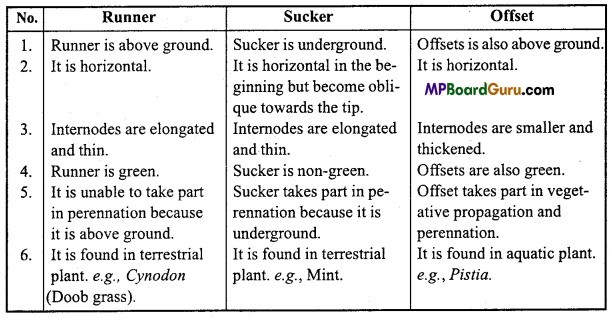
![]()
Question 27.
Write differences between Stolon and Runner.
Answer:
Differences between Stolon and Runner
| Stolon | Runner |
| 1. It is a slender lateral branch that arises from the main axis. | There are narrow green, prostate branches develop at the base of erect shoot. |
| 2. Size of internodes are longer. | Size of internodes are shorter. |
| 3. It grows under the ground upto certain distance, then come up of the soil. e.g., Colocasia. | It grows above the ground. e.g., Doob grass.
|
Question 28.
What is pseudo stem?
Answer:
In some monocot stem leaf base becomes broad and flat and covers a part of the node of stem and sheathing of many leaves jointly make a stem like structure known as false stem or pseudo stem e.g., Banana.
Question 29.
Write name of two monocot plants whose leaves contain reticulate venation.
Answer:
Smilax and Dioscorea.
Question 30.
Write short note on phyllotaxy.
Answer:
Phyllotaxy is the arrangement of leaves on the stem and branches. The leaves of each plant are arranged in a definite pattern on the stem or branches. Main purpose of phyllotaxy is to provide sufficient light to the leaves. When a single leaf arises at each node and two leaves at adjacent nodes are held opposite to each other the leaves are called alter¬nate. The phyllotaxy is opposite when two leaves arise from each node in opposite directions but when more than two leaves arise from each node and form a whorl around it, they are called whorled.
Question 31.
What is Isobilateral leaf?
Answer:
In Isobilateral leaf both the surfaces are equally illuminate as both the surfaces can face the sun. So, the two surfaces can face the sun. e.g., wheat, rice.
Question 32.
Why insectivorous plants catches insect as a food?
Answer:
Insectivorous plants are present in swampy areas where deficiency of nitrogen occur. For fulfil this deficiency the plant catches insects.
e.g., Pitcher plant, Utricularia.
![]()
Question 33.
What are stipules?
Answer:
Leaves of some plants have lateral outgrowths on each side of leaf base, which are called to be as stipules. The leaves without stipules are known as exstipulate. Main function of stipules is to protect the leaf in the bud. When green, these synthesize food also.
Question 34.
What are dorsiventral leaves?
Answer:
A leaf is called as dorsiventral when it grows in such a way that the ventral surface gets more sunlight and is bright green in colour, whereas the dorsal surface gets less light and dull-green in colour.
Question 35.
Write differences between Parallel and Reticulate venation.
Answer:
Differences between Parallel and Reticulate Venation
| Parallel Venation | Reticulate Venation |
| 1. Veins in the lamina run almost parallel to one another. | Midrib is centrally placed and veinlets irregularly distributed forming a network. |
| 2. This type of venations are found in the leaves of Monocot plants. e.g., wheat, rice etc.- | This type of venations are found in the leaves of Dicot plants, such as rose, mango etc. |
Question 36.
What is a flower?
Answer:
Flower is a modified shoot, the leaves of which are modified into specialized structures called as floral leaves. A typical flower consists of two accessory whorls Calyx and Corolla and two essential whorls Androecium and Gynoecium.
Question 37.
Write floral formula of a flower, which is actinomorphic, hermaphrodite, hypogynous, 5 sepals, gamosepalous, 5 petals, polypetalous, 5 stamens, polyandrous, bicarpellary syncarpous with superior ovary.
Answer:
Floral formula: ![]()
Question 38.
What is floral diagram?
Answer:
The diagrammatic representation of no. of individual members of different floral whorls and their arrangement is called floral diagram.
![]()
Question 39.
Explain floral formula along with example.
Answer:
The symbolic representation of the number of individuals present in different floral whorls, their arrangement and general characteristics of the flower is called floral formula, e.g., The structure of the flowers of mustard plant can be expressed by the following floral formula:

Question 40.
Write the floral formula of Cruciferae family.
Answer:
![]()
Question 41.
What is androphore and gynophore?
Answer:
In flowers, in between corolla and androecium, structure is present called androphore and in between androecium and gynoecium a floral structure is called gynophore. Both are collectively called gynandrophore.
Question 42.
Write the floral formula of ray and disc florets present in sunflower.
Answer:
Ray florets : ![]()
Disc florets : ![]()
Question 43.
What do you mean by hypogynous flower?
Answer:
When the ovary occupies the highest position and the stamen, petals and sepals are developed below the ovary, the condition is known as hypogyny and the flowers are called hypogynous. In a hypogynous flower, therefore the ovary is superior, e.g., Mustard, Brinjal, China rose, etc.
Question 44.
Write floral formula of Chinarose flower.
Answer:
![]()
Question 45.
What is actinomorphic flower?
Answer:
The flower which can be divided into two equal half portions by any plane are called actinomorphic flower.
![]()
Question 46.
Write differences between Superior and Inferior ovary.
Answer:
Differences between Superior and Inferior Ovary
| Superior Ovary | Inferior Ovary |
| 1. Thalamus is conical or ball shaped. | Thalamus is flask shaped. |
| 2. Position of ovary is superior. | Position of ovary is inferior. |
| 3. Flower is hypogynous. e.g., China rose. | Flower is epigynous. e.g., Sunflower. |
Morphology of Flowering Plants Class 11 Important Questions Short Answer Type
Question 1.
Give general characteristics of stem.
Answer:
General characteristics of stem :
- It is negatively geotropic and positively phototropic.
- It develops from the plumule portion of the embryo during seed germination.
- It is differentiated into nodes and intemodes. Leaves are borne on the nodes.
- Axillary buds are found at the axil of leaves.
- Apical bud is found at the terminal end of the stem, which helps to increase size of the stem.
- The branches of the stem are exogenous in origin.
- Multicellular stem hairs are found on the stem.
Question 2.
Write any four differences between Root and Underground stem.
Answer:
Differences between Root and Underground Stem
| Root | Underground Stem |
| 1. Nodes and intemodes are absent. | Nodes and intemodes are present. |
| 2. Scale leaves are absent. | Scale leaves are present. |
| 3. Axillary buds and terminal buds are absent. | Axillary buds and terminal buds are present. |
| 4. Adventitious roots do not arise from it. | Adventitious roots grows from its nodes. |
| 5. Root hairs and root caps are found. | Root hairs and root caps are not found. |
Question 3.
Give functions of the stem.
Answer:
Functions of the stem :
- The stem acts as the main support for the branches and leaves.
- It prepares food by photosynthesis process in young stage.
- It helps in conduction of water and minerals absorbed by the roots.
- It helps in translocation of food materials synthesized by the leaves to different parts of the plant.
- In desert plants, it helps to prepare and store food.
- In some plants, it helps for vegetative propagation. Example : Potato, Ginger.
- In some plants, stem is modified into thorn which is mainly defensive in function.
![]()
Question 4.
Give general functions of leaf.
Answer:
General functions of leaf:
- It manufactures food material by photosynthesis process.
- It helps for exchange of gases through stomata.
- It helps for transpiration through stomata.
Question 5.
Give special functions of leaf.
Answer:
Special functions of leaf:
- Some leaves store food materials in them.
- Some leaves are modified for defence, climbing, reproduction etc.
- Some leaves changes their colour and help for pollination by attracting insects and animals.
- Some leaves help for vegetative propagation.
- Some leaves are modified into roots and help for absorption of water and minerals.
Question 6.
Distinguish between Phylioclade and Phyllode.
Answer:
Differences between Phylioclade and Phyllode
| Phylioclade | Phyllode |
| 1. Flattened green aerial stem performs photosynthesis. | Flattened green petiole performs photosynthesis. |
| 2. Nodes and intemodes are well developed. | Nodes and intemodes are totally absent. |
| 3. They take part in vegetative reproduction. | They never take part in vegetative |
| 4. It may bear flowers, scale leaves, bristles or spines. | Phyllode never bear such structures. |
| 5. It originates from axil of leaf. | It originates from axil of bud. |
| 6. It may store food material, mucilage and large quantity of water for future use. e.g., Opuntia. | It generally never stores such substances. e.g., Australian Acacia. |
Question 7.
Give functions of calyx.
Answer:
Functions of calyx :
- Protection of floral organs in bud condition.
- Provide support to the base of mature flower.
- Attraction of insects and help in pollination when they are coloured.
- Dispersal of fruits and seeds.
- Help in photosynthesis because they contain chlorophyll.
![]()
Question 8.
What do you mean by adhesion of stamens? Describe its various types.
Answer:
Adhesion : Fusion among members belonging to different whorls of flower is called as Adhesion.
Following are the different types of adhesion of stamen to other floral whorls :
- Epipetalous : When the filaments are fused to the petals to a greater or lesser extent.
Example: Datura. - Epiphyllous : When the filaments are fused to the petals of perianth.
Example: Onion. - Gynandrous : When the stamens adhere to the gynoecium either loosely or very intimately.
Example: Calotropis. - Gynostegium : A protective covering of gynoecium formed by the androecium and not involving any fusion between the androecium and the gynoecium.
Example: Orchidaceae.
Question 9.
What do you mean by insertion of floral leaves?
Or,
What do you mean by hypogynous, perigynous and epigynous ovary?
Answer:
Insertion of floral leaves : Position of the gynoecium and other floral whorls like calyx, corolla and androecium on the thalamus is called as insertion of floral leaves. It is of following three types :
1. Hypogynous :
When thalamus swells to form a ball like structure then the ovary of the gynoecium occupies the highest position on the thalamus and the stamen petals and sepals develops below the ovary on the thalamus. This type of insertion is called as Hypogynous. The ovary in this case is superior, e.g., Mustard.
2. Perigynous :
In this type the periphery of the thalamus expand to varying degrees making the thalamus disc shaped, cup shaped or flask shaped. The apex of the thalamus lies at the centre to which ovary of the gynoecium is found attached. The remaining parts are borne on the periphery.
Example : Pisum sativum. The ovary in this case is half inferior.
3. Epigynous :
The thalamus is hollowed out in the form of a cup or flask but its internal walls are fused with the wall of the ovary. Only the style and stigma of the pistil are observable in this condition. The other parts of the floral leaves are borne at the top of the ovary.
The ovary is termed as inferior and the thalamus is called as Epigynous.

Question 10.
What do you understand by modification of roots ? Which type of modifications are found in following :
(a) Banyan,
(b) Turnip,
(c) Mangrove?
Answer:
Modification in roots:
Besides the common functions like absorption and fixation the roots are further modified to perform specialized functions such as storage of food, support, respiration etc. This is known as modification.
(a) Banyan :
In banyan trees adventitious roots arise from horizontal branches, grow vertically downwards and penetrate into the soil. These branches increase in thickness by secondary growth and give mechanical support to the horizontal branches. This type of modification of root in banyan tree is called as Prop root.
(b) Turnip :
In turnip tap root is swollen to form spherical shaped structure, which is tapering at the lower part due to storage of food. This type of modification of root in turnip is called as Napiform root.
(c) Mangrove :
Mangrove plants grow in saline swamps or marshy areas, which develop special kind of roots called as respiratory roots or pneumatophores. Roots of these plants do not have proper gaseous exchange due to saline and marshy areas, thus some roots (pneumatophores) grow vertically up and become negatively geotropic, which are provided with air pores called lenticels. Lenticels help for gaseous exchange during respiration.
![]()
Question 11.
On the basis of external features give reason for following statements :
(a) All underground parts of plants are not roots.
(b) Flower is a modified shoot.
Answer:
(a) All underground parts of plants are not roots :
It is true that root always
grows down into the earth but some stems are exceptions. Such as ginger, onion and potato. These are examples of underground modification of stems.
Tuber of potato is an underground modification of stem. When a tip of a positively geotropic lower branch of potato stem swells-up due to the accumulation of reserve foods then a potato tuber is formed.
We can differentiate tuber of potato from root by following points :
- Nodes and intemodes are found in it.
- Scale leaves are found in it.
- Buds are found in the form of eyes.
- It is a modified structure for storage of food.
(b) Flower is a modified shoot:
Following points prove that flower is a modified shoot:
- Thalamus of the flower looks like a stem in which nodes and intemodes are condensed.
- The phyllotaxy of floral leaves is similar to those of vegetative leaves. Actually they are modified leaves to perform special functions.
- Sepals of some plants look like leaves which proves that sepals are modified leaves, e.g., Water lily.
- In some plants thalamus elongates and exhibits clear nodes and intemodes. It con¬firms the view that thalamus is a modified branch.
- Like stems flower also develops from a bud.
Question 12.
How Pinnate compound leaf differs from Palmate compound leaf?
Answer:
There are two types of compound leaves :
1. Pinnate compound leaf and
2. Palmate compound leaf, which differs from each other in following ways :
1. Pinnate compound leaf:
The leaf blade is divisible into several leaflets, arranged laterally on the midrib portion. It is of four types :
(a) Unipinnate : When the rachis directly bears the leaflets. In this, rachis acts as midvein and the leaflets are found on its either side.
e.g., Rose, Cassia.
When, there are even numbers of leaflets on the midrib, it is known as paripinnate, e.g., tamarind, and when there are odd number of the leaflets on the midrib it is called as imparipinnate. e.g., Rose, Neem.
(b) Bipinnate : In this type rachis branches only once and bears the leaflets.
Example: Gulmohar.
(c) Tripinnate: When the secondary branches divides once again bearing the leaflets.
Example: Moringa.
(d) Decompound : When there are more than three incisions of the lamina.
Example: Coriander.
2. Palmate compound leaf:
In this type margin of leaf is incised to divide the base of the blade or the petiole in such a manner so that the leaf blade is divided into a number of segments or leaflets. The arrangement of the leaflets look like the fingers of human palm and hence this type of the compound leaf is known as Palmate compound leaf. Depending upon the number of leaflets they are divided into the following types :
(a) Unifoliate : A unifoliate compound leaf is the result of reduction of all leaflets of a multifoliate compound leaf, except the terminal leaflets as in Citrus sp.
(b) Bifoliate : When there are only two leaflets as in Hardwickia.
(c) Trifoliate : When there are three leaflets as in Aegel marmelos.
(d) Quadrifoliate : When there are four leaflets as in Oxalis and Marsileas.
(e) Multifoliate or Digitate: When more than four leaflets are present as in Salmalia sp.
![]()
Question 13.
Describe various kinds of phyllotaxy with example.
Answer:
Phyllotaxy is defined as the arrangement pattern of leaves on the stem and branches in order to provide sufficient light and air. It is interesting to note that leaves are never arranged haphazard but with mathematical precision at definite and regular intervals.

Type of phyllotaxy:
This is usually of three types:
1. Alternate : From each node, single leaf arises, two leaves arise from the adjacent nodes and are held opposite to each other, e.g., Sunflower, Mango. These may be of the following types:
- Distichous,
- Tristichous,
- Pentastichous.
2. Opposite :
Two leaves are present on a single node but are opposite to each other that is at 180° to each other. It may be of two types :
- Opposite superposed : When the successive pairs of leaves are placed one above another forming two vertical rows when seen from the top. e.g., Guava.
- Opposite decussate : When are pair of leaf is placed at right angle to the next e.g.
Tulsi.

3. Whorled or Verticillate :
When there are more than two leaves at each node,arranged in a circle or whorled.
![]()
Morphology of Flowering Plants Class 11 Important Questions Long Answer
Question 1.
Define following terms :
(a) Aestivation,
(b) Placentation,
(c) Actinomorphic,
(d) Zygomorphic,
(e) Superior,
(f) Perigynous,
(g) Epipetalous.
Answer:
(a) Aestivation : Aestivation is the arrangement of floral leaves (Calyx, corolla or perianth) in the bud condition. The various types of the aestivation are :
- Valvate,
- Twisted,
- Imbricate,
- Descending imbricate,
- Quincuncial.
(b) Placentation :
The arrangement of the ovules on the placenta of ovary is called as Placentation. The various types of placentations are :
- Marginal,
- Parietal,
- Basal,
- Axile and
- Free central type.
(c) Actinomorphic :
When the flower can be divided into two equal halves along more than one vertical plane passing through the middle of the flower then the flower is called as Actinomorphic. e.g., China rose.
(d) Zygomorphic:
When flower can be divided into two equal halves along only one plane then flower is called as Zygomorphic. e.g., Pea.
(e) Superior :
When thalamus of the flower is ball or conical shaped then position of ovary is superior to all other parts of the flower. Such ovary is called as Superior ovary. e.g., China rose, Mustard, Brinjal etc.
(f) Perigynous :
When thalamus of the flower is cup shaped and position of the ovary as compared to other floral parts is half inferior then the flower is called as Perigynous. e.g., Pea, rose, bean etc.
(g) Epipetalous :
When the filaments of stamens are fused to the petals to a greater or lesser extent then stamens are called as Epipetalous. e.g., Dhatura.
![]()
Question 2.
Write differences between following :
(a) Racemose and Cymose inflorescence
(b) Tap root and Adventitious root.
(c) Apocarpous and Syncarpous.
Answer:
(a) Differences between Racemose and Cymose Inflorescence
| Racemose Inflorescence | Cymose Inflorescence |
| 1. The main axis shows indefinite growth. | The main axis shows definite growth. |
| 2. Main axis gives off flowers laterally. | The main axis and its branches terminate in flower. |
| 3. Flowers grow in acropetaf succession. | Flowers grow in basipetal succession. |
| 4. The order of opening of flowers is centripetal. | The order of opening of flowers is centrifugal. |
(b) Differences between Tap and Adventitious Root Systems
| Tap Root System | Adventitious Root System |
| 1. Tap roots arise from the radicle of embryo. | These roots are arising either from stem or from the leaves. |
| 2. The primary root formed from the elongation of radicle, is long-lived. | It is short-lived. |
| 3. Tap roots are deep feeder. | It may usually be surface feeder. |
| 4. There is a single main root. | There are a number of roots arising in clusters. |
| 5. Main root is very thicker than other roots. | All roots are fibrous. |
| 6. This root system is usually found in dicotplants. | This root system is usually found in monocot plants. |
| 7. It is always underground and meant for anchorage. | Adventitious roots may be underground for anchorage or aerial for performing specialized functions like assimilation, support, etc. |
(c) Differences between Apocarpous and Syncarpous
| Apocarpous | Syncarpous |
| 1. The gynoecium with many free carpels is described as Apocarpous. e.g., Family Rannunculus. | The gynoecium with two or more carpels which are fused is described as Syncarpous. e.g., China rose, Dhatura. |
Question 3.
What is flower? Describe various parts of a typical angiosperm flower.
Answer:
Flower is a modified shoot which performs the function of sexual reproduction and arises either at the tip of a branch or at the axil of a leaf. It leads to formation of fruits and seeds.
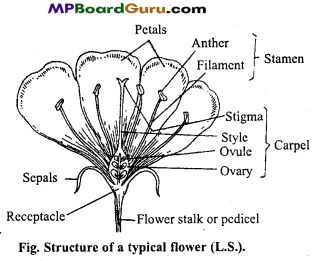
A typical flower has following four parts :
- Calyx,
- Corolla,
- Androecium,
- Gynoecium.
(A) Accessory parts of flower :
(1) Calyx :
Outermost whorl of the flower is called as Calyx. Unit structure of calyx is called as Sepal. It protects the flower in bud condition. Generally it is green in colour due to presence of chlorophyll, thus can prepare food by photosynthesis process.
(2) Corolla :
It is the second whorl of the flower, which consists of unit structures called as Petals. Generally it is large and colourful to attract insects for pollination.
(B) Essential parts of the flower :
(3) Androecium :
It is the male reproductive part of the flower which forms third whorl of the flower. Unit structure of androecium is called as Stamen. Each stamen consists of three parts :
- Filament,
- Anther and
- Connective. Pollen grains are formed inside the anther. Male gametes are formed in the pollen grains.
(4) Gynoecium :
It is the innermost and fourth whorl of the flower. It is the female reproductive part of the flower. Unit structure of gynoecium is called as Carpel or Pistil. Each pistil consists of three parts:
- Stigma,
- Style and
- Ovary. Egg is formed in the ovules present in the ovary.
![]()
Question 4.
Describe various types of placentations found in flowering plants.
Answer:
Placentation : The arrangement of the ovules on the placenta of the ovary is called as placentation. It is of the following types :
(i) Marginal:
It is found in monocarpellary pistils which bears a longitudinal placenta on the ventral surface. The placenta bears one or two rows of ovules.
Example: Pea.
(ii) Parietal:
The parietal placenta shows two or more than two placentae attached to the wall of ovary. It is found in syncarpous pistils with unilocular ovary. The ovules are borne near the periphery of the ovary and the placenta are situated on the fused margins of the adjacent carpels.
Example: Poppy, Mustard.
(iii) Basal:
The pistil is usually polycarpellary and syncarpous. The ovary is unilocular and possesses one placenta which bears a single ovule towards the base of the ovary.
Example: Helianthus (Sunflower).
(iv) Superficial:
Here the ovules are not restricted to the margins of the carpels but are found on the whole inner surface of the ovary.
Example: Nymphaea.
(v) Axile :
It is found in polycarpellary syncarpous pistils. The ovary is partitioned into two or more chambers or loculi depending upon the number of the fusing carpels. The placentas are found in the centre of the ovary at the place of union of the septa so that a central or axile column is formed which bears the ovules.
Example: China rose.
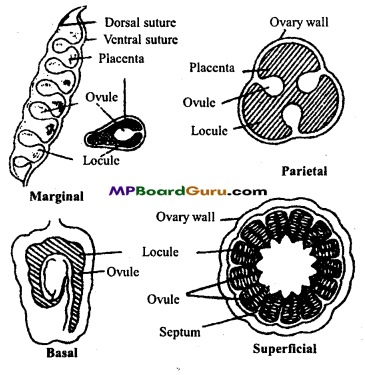

(vi) Free central:
In this case the pistil is polycarpellary and syncarpous but ovary is unilocular. The ovules are found all around a central column which runs throughout the middle of the ovary.
Example: Dianthus.
![]()
Question 5.
How modifications of leaves are helpful to plants?
Answer:
Main function of leaves are photosynthesis and transpiration. In order to perform certain peculiar function the leaves change their shape accordingly. However the main types of modifications are as follows :
1. Leaf spines :
When leaf is modified into sharp pointed slender structures called as spines. They provide protection to the leaf and also checks excessive transpiration.
Example : Asparagus, Ulex etc.
2. Leaf tendrils :
Tendrils are slender wiry often closely coiled structures which helps in climbing of the plant on its support, Whenever they come in contact with a neighbouring living or non-living object they coil around it and help the plant to rise up. For this purpose either full leaf or some leaflets are changed into tendrils.
Example : Pisum sativum, Begonia etc.
3. Leaf hooks :
Here leaf is modified into thick sharp, stiff and curved structures called as hooks. These hooks cling to the bark of a tree and support the climbing plant.
Example: Begonia.
4. Scale leaves :
When leaf is reduced in the form of thin, dry membranous structure to protect the axillary buds in their axil. They are frequently observed in case of underground modification of stem.
Example : Potato, Ginger, Onion etc.
5. Storage leaves :
Leaves of some plants become fleshy due to storage of water and food material, such leaves are called as storage leaves.
Example : Agave, Aloe, Bryophyllum etc.
6. Leafy roots :
When the leaf modified into a root like structure.
Example: Salvinia.
7. Leaf pitcher:
When the entire or a part of the leaf is changed into a dilated pitcher like structure to catch insects to fulfil their nitrogen requirement.
Example : Nepenthes, Dischidia rafflesiana.
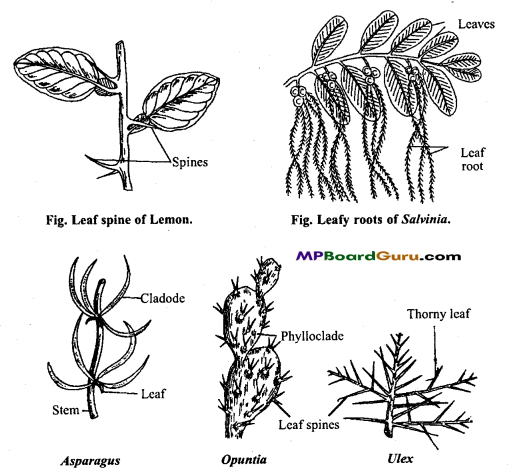
8. Leaf bladders:
When some leaves are modified into small oval or circular bladder into a trap-door entrance. This modification is most conspicuous in insectivorous but not in hydrophytic plant species like Utricularia.
Example: Utricularia.
![]()
Question 6.
Define inflorescence. Describe on the basis of types of inflorescence found in flowering plants.
Answer:
Inflorescence:
Arrangement of flowers on the floral axis of a plant is known as inflorescence. The central axis of an elongated inflorescence is called as Peduncle.
In some plants flowers arise singly at the apex and are called as Solitary terminal flowers as in Poppy. In some cases like Oxalis, guava etc., single flowers arise in the axil of the leaf and are called as Solitary axillary flowers. The inflorescence may be of following types:
(A) Simple inflorescence,
(B) Compound inflorescence,
(C) Special inflorescence and
(D) Mixed inflorescence.
(A) Simple inflorescence : When flowers are directly bom on the main axis. It is of two types :
(1) Racemose or indefinite : When the growth of the inflorescence continues indefinitely and produces flowers laterally in acropetal succession. It may be of following types :
(a) Typical raceme : e.g.,Mustard
(b) Spike : e.g., Amaranthus
(c) Spikelet: e.g., Wheat
(d) Spadix : e.g., Banana
(e) Catkin : e.g., Mulberry
(f) Umbel: e.g., Coriander
(g) Corymb : e.g.Jberis amara
(h) Capitulum or Head: e.g., Sunflower.
(2) Cymose or definite :
When the growth of the main axis is limited as the terminal bud is modified into a flower. The subsequent flowers are produced in basipetal succession. It may be of following types:
(a) Uniparous or Monochasial cyme : It is of two types :
(i) Helicoid cyme : e.g., Begonia
(ii) Scorpioid cyme : e.g., Heliotropium.
(b) Biparous or Dichashial cyme : e.g., Ixora
(c) Multiparous or Multichashial cyme : e.g., Calotropis.
(B) Compound inflorescence : When the main axis of the inflorescence is branched and the branches bear flowers of the inflorescence, it is called as compound inflorescence. It is of following types :
(a) Compound raceme : e.g.,Goldmohar,
(b) Compound spike : e.g., Spinach,
(c) Compound spadix : e.g., Coconut,
(d) Compound corymb : e.g., Cauliflower,
(e) Compound umbel: e.g., Coriander.
(C) Special inflorescence :
There are certain inflorescences which do not agree to the characteristics already described above. So these may be grouped under the special types and are of the following types :
(a) Cyathium : e.g., Euphorbia
(b) Verticillaster : e.g., Oscimum (Tulsi)
(c) Hypanthodium : e.g., Peepal.
(D) Mixed inflorescence: When the inflorescence is neither true racemose nor cymose but a mixture of two, it is said to be mixed inflorescence. It is of following types :
(a) Spadix of cyme : e.g., Musa sp.
(b) Cyme of umbels : e.g., Lantana
(c) Cyme of corymb : e.g., Oldenlandia, corymbosa.
(d) Cyme of capitula : e.g., Vernonia.
![]()
Question 7.
Give one-one example of Fabaceae and Solanaceae families and describe them in biotechnical language and draw their floral diagrams.
Answer:

(A) Family Fabaceae : Family Fabaceae was earlier called as Family Papilio- naceae. Pea plant represent Family Fabaceae or Papilionaceae.
Description of Pea flower (Pisum sativum):
- Inflorescence: Generally racemose. In Crotolaria, it is terminal raceme, in Melilotus it is corymbose raceme whereas in Cicer arietinum it is solitary axillary.
- Flowers : Pedicellate, bracteate, bisexual, zygomorphic, hypogynous or perigy- nous, complete and pentamerous.
- Calyx : 5 sepals, gamosepalous, campanulate or tubular, imbricate aestivation.
- Corolla: 5 petals, polypetalous, papilionaceous, posterior petal is largest and known as standard. Two lat¬eral petals are known as wings. Two anterior petals fuse to form boat shaped keel. The aestivation is vexillary.
- Androecium: Generally, 10 stamens are present in two groups 9 + 1. It is known as diadelphous condition. The 9 stamens are fused through filament. In Crotolaria and Pongamia, it is monoadelphous. Anthers are dithecous, basifixed and introse.
- Gynoecium : Monocarpellary, unilocular, su¬perior or half inferior. Marginal placentation. Style simple, stigma capitate.
- Fruits : Legumes or Pods.
- Seeds: Non-endospermic.
- Floral formula:
Pisum sativum : im
(B) Family Solanaceae :
Dhatura flower belongs to Family Solanaceae.
Description of Datura alba (Dhatura) flower :
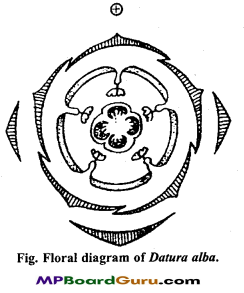
- Inflorescence : Inflorescence seen in the plants is of cymose type. Datura shows dichasial cyme, Solarium shows helicoid cyme, Atropa belladonna shows scorpioid cyme and Nicandra shows solitary axillary type of inflorescence.
- Flower : Usually the flowers are pedicellate, bisexual, complete, pentamerous, actinomorphic, hypogynous and bracteate or ebracteate. Flower is zygomorphic in Hyosymus niger and Salpiglossis. The flowers of Salpiglossis are always cleistogamous.
- Calyx : 5 sepals, gamosepalous, hairy, persistent with twisted aestivation.
- Corolla : 5 petals, gam’opetalous, usually white in colour with valvate aestivation.
- Androecium : 5 stamens, polyandrous, epipetalous, filament hairy with long anthers.
- Gynoecium : Bicarpellary, syncarpous, bilocular, oblique ovary, superiorly placed. Placentation is axile with numerous swollen ovules found on the placenta. Style is simple and stigma is bilobed.
- Fruits : Fruits are either of berry type e.g., Tomato, Brinjal etc. or capsule type e.g., Durantum.
- Seeds : Seeds are endospermic.
- Floral Formula :

![]()
Question 8.
Explain modification of adventitious roots for storage of food.
Answer:
Modification of adventitious roots for storage of food : Following modifications are found in adventitious roots for storage of food :
1. Fasciculated roots : These are like the tuberous roots but occur in a fascicle or cluster at the base of the stem.
Example : Dahlia, Asparagus etc.
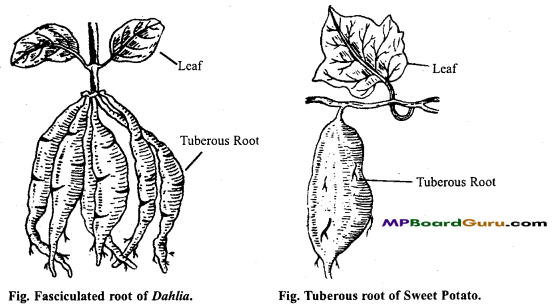
2. Tuberous roots: The root is swollen and fleshy and may assume any shape, rounded, fusiform or any irregular shape, e.g. Sweet potato.
3. Nodulated roots : In this type, the fibrous adventitious roots abruptly become swollen at the tip.
Example : Curcuma amada (Haldi).
4. Moniliform roots : In this type, the root shows alternately swollen and thin portions.
Example: Pasella, Vitis.
5. Annulated roots : In this type, the root shows a series of ring like swellings separated by ring like grooves.
Example : Cephaelis, Ipecac uanha.

Question 9.
Explain modification of adventitious roots for providing mechanical support to the plant.
Answer:
Modification of adventitious roots for providing mechanical support: Following types of modifications are found in adventitious roots for providing mechanical strength:
1. Prop root:
These roots give support to the branches of a tree as the props in a tent. In the Banyan tree (Ficus benghalensis) the prop roots arise from the horizontally growing branches. The prop roots hang down vertically for quite a number of years and then enter the soil. The branches rest on them. The Great Indian Banyan Tree of the Indian Botanical Garden, Sibpur, Calcutta has produced more than 800 such prop roots. It is 200 years old and has occupied 300 sq.m. area.
2. Stilt root:
Stem of monocot plants are very weak and can not stand straight due to their weight. Some roots arise from the basal nodes of such stem and grow obliquely downward, ultimately strike the ground and thus support the plant. These roots are called as stilt root.
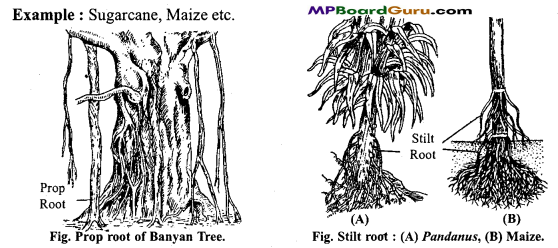
3. Buttress root:
The buttress roots are plate like structure formed by the bases of the main roots of tropical trees. It provides support to the plant.
Example : Prombab malabaricum.
Fig. Buttress root.

4. Climbing root:
These roots arise from the nodes of a climbing stem and cling very tenaciously to the substratum which may be a wall or the trunk of tree and thus help the plant in climbing.
Example : Money plant, Black pepper, Pan.
5. Clinging root:
These roots are found in epiphytes. These roots secrete a sticky substance which quickly dries up and aids in the sticking of the root to substratum.
Example: Vanda.
![]()
Question 10.
Write down the modification of tap root.
Or,
Explain modification of tap root for food storage with diagram.
Answer:
Modification of tap root:
(I) For food storage:
The tap root becomes swollen and fleshy with the stored food. The secondary roots remain thin. Hypocotyl (embryonic region between cotyledons and radicle) may also join the tap root in storing food. Stem is reduced and discoid in the beginning and bears radicular leaves. Depending upon the shape, the fleshy tap roots are of the following types:
1. Fusiform roots :
When the root is swollen in the middle and gradually tapering towards the apex and base it is called a fusiform root. It is more or less spindle shaped, e.g., Radish (Raphanus sativus).
2. Conical roots:
When the root is broad at the base and gradually tapers towards the apex like a cone, it is said to be conical root. It bears many secondary roots throughout the length, e.g., Carrot (Daucus carota).
3. Napiform roots :
When the root is considerably swollen at the upper part and becoming almost spherical and shaiply tapering at the lower part, it is said to be napiform. e.g., Turnip or Saljam (Brassica rapa), Beet root (Beta vulgaris). Base of root shows radicular leaves. In turnip most of the swollen part is formed hypocotyl. The lower narrow, pointed apical region bears threadlike secondary roots. In beet both the tap root and hypocotyl are swollen.

4. Tuberous roots :
These roots are thick and fleshy and do not maintain any definite shape, e.g.. Four o’clock (Mirabilis jalapa), Parwal (Trichosanthes), etc.
(II) For respiration (Pneumatophore or Respiratory roots):
Many plants growing in estuaries, saline swamps, marshes and salt lakes develop special kinds of roots called respiratory roots or pneumatophores. The plants which develop pneumatophores are called halophytes. These plants do not have proper gaseous exchange due to saline conditions, as a result their growth becomes hindered.
Pneumatophores are helpful in respiration. From the underground roots of the plant, pneumatophores grow vertically upwards and come out of the water in the form of conical spikes. They occur in large numbers around the tree trunks and are provided with air pores called lenticels. Air pores help in proper respiration. e.g., Rhizophora, Avicenna, Sonneratia, Heritiera (vem. Sundri), Kutch vegetation, Mangroves, etc.
Question 11.
Describe various underground modifications of the stem.
Answer:
Underground modifications of the stem : Such stems which grows under the ground are called as underground modifications of stems. It helps plants to survive in unfavourable condition. Stem become modified in various ways for certain special functions, i.e., storage of food material and vegetative propagation.
Following types of modifications are found in underground stem :
1. Rhizome,
2. Stem tuber,
3. Bulb,
4. Corm.
1. Rhizome:
It is a perennial underground stem which shows unlimited growth and develops in favourable condition to form upright shoot and leaves. It is a prostrate, thickened stem, creeping horizontally under the surface of the soil. It is provided with distinct nodes and long or short intemodes. It possesses a bud in the axil of scaly leaf and it ends in a terminal bud. From underside adventitious roots grows.
Example: Ginger, Fern.
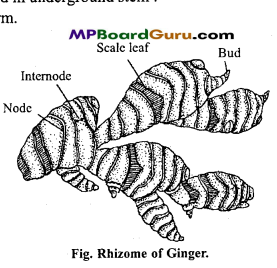
2. Stem tuber:
The tubers are solid, thick¬ened stems or branches serving for storage of food and also vegetative propagation. When it develops from root it is called root tuber but when it develops from stem it is called as stem tuber. In Potato plant, tip of a positively geotropic, fleshy stem growing in a vertical direction swells due to the accumulation of reserve foods. These tubers bear temporary scale leaves with buds in their axils called ‘eyes’. Even a single detached bud may grow into a new plant. In this way it helps for vegetative propagation.
Example : Potato.
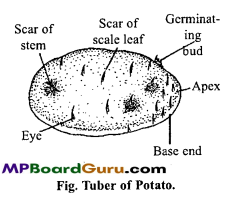
3. Bulb :
The bulb is a specialized underground reduced stem. In this the stem remains comparatively small and the food material is stored in the large, fleshy scales which invest and overlap the stem. However the stem is no more than a thick disc or very flat cone, but it has an apical bud on the upper side, and adventitious roots are formed in an annual plant from the marginal portion of the underside.
There are two types of bulbs:
(a) Tunicated bulb : In this type of bulb, one scale leaf totally overlap another. Towards the outside cover of dry scale leaves are found.
Example: Onion.

(b) Scaly bulb : In scaly bulb, the fleshy scale composing the main bulk overlap at their margin. No tunic is found to enclose the whole buds.
Example: Garlic.
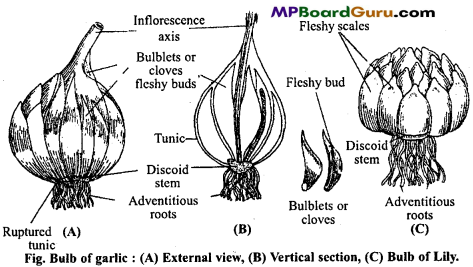
4. Corm:
Corm is st, fleshy and thickened underground em growing in
vertical directions. There are many buds present in the axil of scale leaves which develop in daughter corms. At the bases or even from sides of stem the adventitious roots develop.Corms are also called condensed rhizomes, help in vegetative propagation and storage.
e.g., Arbi or Ghuiyan (Colocasia), Zimikand (Amorphophallus), Crocus.

![]()
Question 12.
Explain the aerial modifications of stem.
Answer:
Aerial Modifications or Metamorphosed Stems :
Sometimes vegetative and floral buds instead of growing into branches and flowers undergo modifications to form specialized structures like tendrils, thorns, phylloclades or bulbils to perform specific functions. These stems are called as metamorphosed stems.
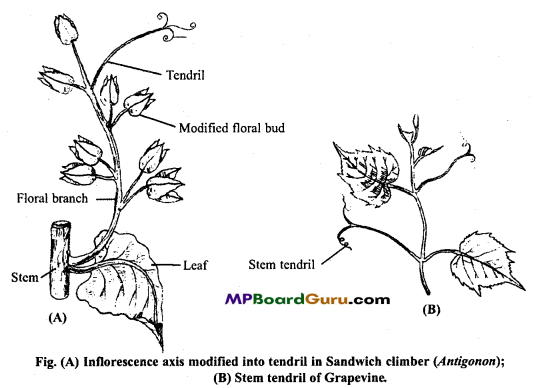
1. Stem tendril:
It is a modification of stem in which axillary bud of leaves modifies, to form a filamentous structure called tendril. They help the plant to attach itself to the support and climb it. They are found in weak stemmed plants. The tendrils are leafless, coiled structures with sensitive tactile pits and adhesive glands to promote fixation of weak stem.
Stem tendrils are of four types :
(a) Axillary : e.g., Passiflora. »
(b) Extra axillary: e.g., Cucurbita, Lagenaria, Luffa.
(c) Leaf opposed : e.g., Grapevine.
(d) Floral bud or Inflorescence tendril: e.g., Antigonon,
Cardiospermum (Balloonvine).
2. Stem thorn :
In this modification, axillary bud is modified into thorn (Duranta) known as stem thorn. Leaves, branches and flowers are developed on thorns. It clarifies that thorn is a modified stem, e.g., Citrus, Bougainvillaea, Pome¬granate, Alhagi, etc.

3. Phylloclade:
It is a modified stem in which stem gets modified into leaflike structures and leaves get modified into spines. The phylloclade is green and flattened (e.g., Opuntia or Nagphani), cylindrical (e.g., Casuarina) or ribbon like (e.g., Zygocactus or Muhlenbeckia) and has distinct nodes and intemodes.
They are green in colour and capable for the synthesis of food by photosynthesis. Formation of phylloclade reduces loss of water through transpiration and therefore conserve water and food. In Opuntia, the phylloclades are fleshy and segmented. Phylloclade develops from branches of unlimited growth. Internally, phylloclades contain many mucilage glands to promote retention of water.
4. Cladode:
These are green stems branches of limited growth (usually one intemode long) which have taken over the function of photosynthesis from the leaves. The true leaves are reduced to scales or spines, e.g., Asparagus, Ruscus, etc. In Ruscus aculeatus, the cladodes are leaflike in appearance with spiny tip, ovate outline and roughly parallel veins. The cladodes are borne in the axils of scale leaves. The stem nature of the cladode of Ruscus is clear from :
- Origin in the axil of scale leaf,
- Bearing a scale leaf in the middle,
- Formation of a bud in the axil of the scale leaf bore in the middle,
- Development of flowers from the axillary bud produced in the middle of cladode.
5. Bulbils :
When axillary bud becomes fleshy and round due to storage of food (as
carbohydrate) then bulbils are formed. These fall down and form new plants, e.g., Aloe, Agave, Onion, Garlic.
![]()
Question 13.
What is Venation? Describe its various types.
Answer:
Venation:
Arrangement of veins and veinlets in the lamina (leaf blade) is known as venation. Veins are the conducting tissues consist of xylem and phloem and are found in continuation with the conducting tissue of petiole.
They are concerned with the conduction of water, mineral, salts and food and they form structural framework of the lamina. There are mainly two types of venations :
(A) Reticulate venation, (B) Parallel venation.
(A) Reticulate venation :
Venation in which veins are arranged in such way that they form a network of vein, is called reticulate venation. It is the characteristic feature of dicot leaves. It is of two types :
1. Unicostate: Venation in which leaflets contain a strong midrib or costa, from which lateral veins are arising and these veins form a network is called unicostate venation, e.g., Mango, Guava, Peepal.

2. Multicostate :
Venation in which many strong veins arising from terminal portion of the stalk and then form a network is called multicostate venation. It is also of two types :
(a) Divergent: Venation in which veins arise from the centre and runs towards margin apart from each other is called divergent venation, e.g., Castor, Cotton.
(b) Convergent: Venation in which many veins arising from the centre of stalk, moving towards the margin of the leaf and finally fused is called convergent venation, e.g., Zizyphus (Ber), Smilax.
(B) Parallel venation :
In this type of venation veins in lamina run almost parallel to one another, e.g., Maize, Grass, etc. It is of the following two types :
1. Unicostate : In this type only one midvein is found from which veinlets arise parallel to each other, e.g., Banana, Canna.
2. Multicostate : In this type more than one mid veins are present. It is of two types :
- Convergent: In this type, all midveins run parallel to each other from the base of lamina and unite at the apex, e.g., Grass, Rice, Bamboo, etc.
- Divergent : In this type, all the midveins, instead of going towards the apex, spread out towards the periphery away from each other, e.g., Borassus (Taad).

Question 14.
What do you mean by aestivation of flower? Describe various types of aestivations found in flower.
Answer:
Aestivation :
Aestivation is the arrangement of floral leaves (calyx, corolla or perianth) in the bud condition. The various types of the aestivations are:
- Valvate: Margins of the adjacent petals touch each other but without overlapping.
Example: Datura. - Twisted: In this type one margin of the petal overlaps regularly the margins of the adjacent petal, the other margin being overlapped by the margin of another adjacent petal.
Example: China rose. - Imbricate : In this type irregular overlapping of petals by one another. It has three subtypes beside the imbricate proper.
Example: Gulmohar. - Quincuncial: In this type two petals are external, two internal and one with one margin external while its other margin is internal.
Example: Pumpkin. - Descending imbricate or Vexillary: In this type the posterior vexillum or standard petal overlapping the two lateral wings or alae, the latter being external to the two anterior petals forming keel or carina.
Example: Pea family.
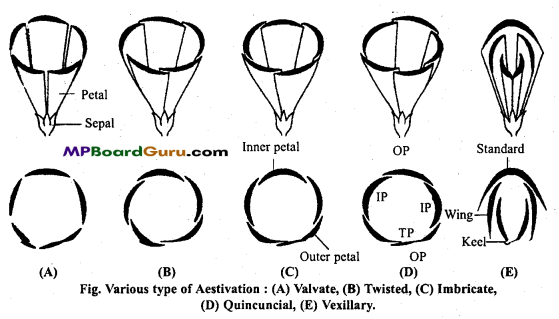
![]()
Question 15.
Explain the types of germination.
Answer:
Types of Seed Germination : There are two types of seed germination takes place in higher plants :
1. Hypogeal germination :
At the time of seed germination when the epicotyl elongates and becomes curved, it brings the plumule above the soil. Cotyledons remain underground. Such types of seed germination is called as hypogeal.
Example: Gram, Pea, Maize, Mango, Jackffuit, Paddy, Wheat, Coconut, Date palm etc.
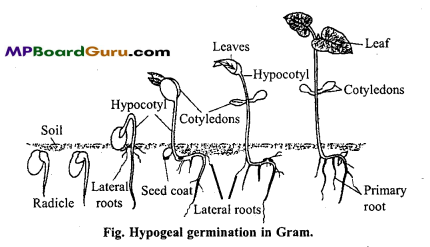
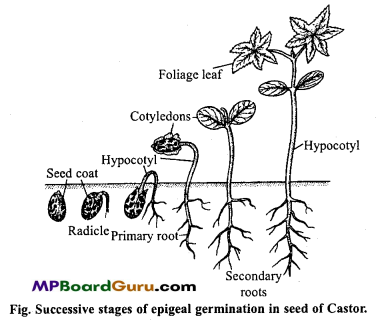
2. Epigeai germination :
In bean, hypocotyl grows actively and becomes curved. It brings the seed above the soil. After coming above the surface of the soil the hypocotyl straightens. The loosened seed coats fall down and cotyledons turn green. Such a type of seed germination is called epigeai. Now epicotyl grows and the plumule gives rise to green leaves. The cotyledons fall down ultimately.
Question 16.
Describe structure of gram seed with labelled diagram.
Answer:
Structure of gram seed :
It is dicotyledonous and non-endospermic seed and is formed in green pod or legume fruit produced on the plant.
External structure :
It is light or dark brown coloured seed. The seed is broad at one end and pointed at the other end. A furrow is found on one side of the seed. A narrow ridge called raphe runs in the furrow. At the middle of raphe an oval shaped chalaza is found. A small oval shaped scar lies on the same side called as hilum. It is the part of the seed by which it was attached to the funicle. In between the hilum and pointed end of seed a small pore is found called as micropyle.

Internal structure :
The gram seed is covered over on all sides by two seed coats. The outer seed coat is brown and hard structure and is called as testa while the inner seed coat is in the form of a white membranous structure called as tegmen. The seed coat encloses embryo containing a short embryo axis. Embryo consists of following parts :
(i) Cotyledons :
Two large and broad structure attached to the embryo axis are called as cotyledons. Food materials are stored in the cotyledons.
(ii) Embryo axis :
The tip of embryo axis towards the micropyle end is called radicle(the future root). The outer end of the embryo axis found deeper in between the cotyledons is the plumule (the future shoot). The part of the embryo axis between the point of attach¬ment of the cotyledons and the plumule is known as epicotyl and that between the point of attachment of cotyledons and radicle as hypocotyl.
![]()
Question 17.
Draw labelled diagram of Longitudinal section (L.S.) of following :
(i) Gram seed,
(ii) Maize seed.
Answer:
(i) Gram seed :
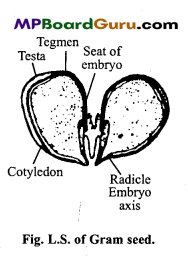
(ii) Maize seed:
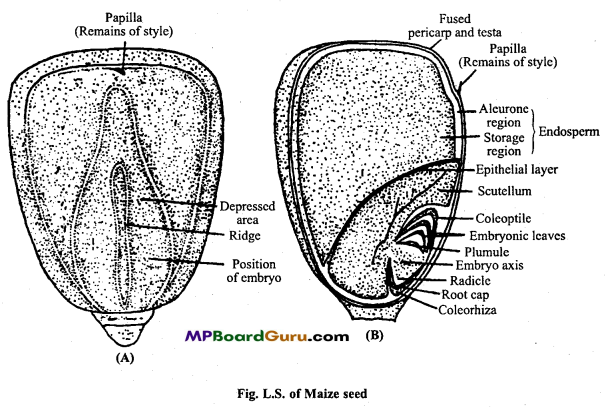
Morphology of Flowering Plants Class 11 Important Questions Objective Type
1. Choose the correct answers:
(A)
Question 1.
Respiratory roots are found in :
(a) Betel
(b) Chestnut
(c) Jussiaea
(d) Maize.
Answer:
(c) Jussiaea
Question 2.
Roots that absorb oxygen from environment are called :
(a) Hygroscopic
(b) Suckers
(c) Digestive roots
(d) Pneumatophores.
Answer:
(d) Pneumatophores.
Question 3.
Velamen cells are found in :
(a) Respiratory roots
(b) Stilt roots
(c) Fleshy roots
(d) Aerial roots of Orchids
Answer:
(d) Aerial roots of Orchids
Question 4.
Which one of the following is not a Rhizome :
(a) Ginger
(b) Colocasia
(c) Lotus
(d) Turmeric.
Answer:
(c) Lotus
Question 5.
Pneumatophores are found in:
(a) Xerophytes
(b) Epiphytes
(c) Mangrove plants
(d) Hydrophytes.
Answer:
(c) Mangrove plants
Question 6.
Respiratory roots help in:
(a) Transpiration
(b) Carbohydrate metabolism
(e) Protein synthesis
(d) Respiration.
Answer:
(d) Respiration.
Question 7.
Which of the following is partial root parasite :
(a) Cuscuta
(b) Orobanche and Balanophora
(c) Striga and Santalum
(d) Loranthus.
Answer:
(c) Striga and Santalum
Question 8.
Sweet potato is a modification of:
(a) Leaf
(b) Adventitious root
(c) Tap root
(d) Stem.
Answer:
(b) Adventitious root
![]()
Question 9.
Type of roots observed in Pandanus is :
(a) Prop roots
(b) Stilt roots
(c) Tuberous roots
(d) Climbing roots.
Answer:
(b) Stilt roots
Question 10.
Adventitious roots:
(a) Develop from radicle
(b) Develop from any part of plant body except the radicle
(c) Develop from flowers
(d) Develop from embryo.
Answer:
(b) Develop from any part of plant body except the radicle
Question 11.
The thick roots that hang down from the Banyan tree are called :
(a) Buttress roots
(b) Pneumatophores
(c) Prop roots
(d) Stilt roots.
Answer:
(c) Prop roots
(B)
Question 1.
Largest (tallest) plants of the world are associated with :
(a) Dicots
(b) Monocots
(c) Angiosperms
(d) Pteridophytes.
Answer:
(c) Angiosperms
Question 2.
Coms in:
(a) A horizontal underground stem
(b) An underground erect stem
(c) An underground root
(d) An underground stem.
Answer:
(b) An underground erect stem
Question 3.
The main function of the stem is:
(a) Storage
(b) To produce branches and leaves
(c) Conduction
(d) All of these.
Answer:
(d) All of these.
Question 4.
Tuber of potato is a modified:
(a) Root
(b) Stem
(c) Creeper
(d) Bulb.
Answer:
(b) Stem
![]()
Question 5.
The underground swollen edible part of onion is:
(a) Root
(b) Bulb
(c) Underground stem
(d) Corm.
Answer:
(b) Bulb
Question 6.
In aerial stems food is stored in :
(a) Large roots
(b) Inflorescence
(c) Swollen stems
(d) Swollen leaf bases.
Answer:
(c) Swollen stems
Question 7.
Stem is enlarged in :
(a) Stem tuber
(b) Corm
(c) Bulbs
(d) Rhizome.
Answer:
(b) Corm
Question 8.
The leafy stem of onion which is growing to bear flower is called:
(a) Peduncle
(b) Rachis
(c) Scape
(d) Floral axis.
Answer:
(b) Rachis
Question 9.
The leaves of Bryophyllum produce small plantlets on its margin. After
separation these plantlets can grow into a new plant. It is a form of:
(a) Sexuaireproduction
(b) Fission
(c) Vegetative propagation
(d) Bisexuality.
Answer:
(c) Vegetative propagation
Question 10.
Adnate stipules are found in:
(a) China rose
(b) Cotton
(c) Rose
(d) Polygonum.
Answer:
(c) Rose
Question 11.
Tendrillar stipules are found in:
(a) Smilax
(b) Bean
(c) Acacia
(d) Magnolia.
Answer:
(a) Smilax
![]()
Question 12.
When petiole is modified into a leafy structure, ¡t is caLled: (CPMT 1987)
(a) Phylloclade
(b) Leafy petiole
(c) Cladode
(d) True leaf.
Answer:
(b) Leafy petiole
Question 13.
Accessory buds are developed on:
(a) Apex of branch
(b) Stem apex
(c) The margins of axillary buds
(d) The axis of leaves.
Answer:
(c) The margins of axillary buds
Question 14.
Leaves are modified into hooks in:
(a) Bignonia
(b) Duranta
(c) Antigonon
(d) Ruscus.
Answer:
(a) Bignonia
Question 15.
Leaf without petiole is called:
(a) Petiolate
(b) Sessile
(c) Pedicellate
(d) Asparagus.
Answer:
(c) Pedicellate
Question 16.
Stipules get modified into tendrils in:
(a) Smilax
(b) Ascodilus
(c) Gloriosa
(d) Asparagus.
Answer:
(a) Smilax
Question 17.
Phyllode represents:
(a) Green stem
(b) Leaf base
(c) Green root
(d) Petiole.
Answer:
(d) Petiole.
Question 18.
Leaflet tendrils are found in :
(a) Clematis
(b) Pea
(c) Gloriosa
(d) Smilax.
Answer:
(b) Pea
![]()
Question 19.
Leaf bladders are found in :
(a) Nepenthes
(b) Utricularia
(c) Drosera
(d) Casuarina.
Answer:
(b) Utricularia
Question 20.
Parallel venation is found in the leaves of:
(a) Castor
(b) Grasses
(c) Moss
(d) Ferns.
Answer:
(b) Grasses
Question 21.
Leaf apex is modified in tendril in :
(a) Pisum
(b) Smilax
(c) Bryophyllum
(d) Rose
Answer:
(d) Rose
Question 22.
The pinnate leaf of Tamarind is :
(a) Tripinnate
(b) Bipinnate
(c) Imparipinnate
(d) Paripinnate.
Answer:
(d) Paripinnate.
Question 23.
In Utricularia, leaf segments are modified into :
(a) Spines
(b) Tendrils
(c) Thorns
(d) bladders.
Answer:
(d) bladders.
Question 24.
Petioles are modified into tendrils in :
(a) Antigonon
(b) Passiflora
(c) Gloriosa
(d) Clematis.
Answer:
(d) Clematis.
Question 25.
A leaf is modified into phyllode in :
(a) Potato
(b) Australian acacia
(c) Citrus
(d) Dalbergia.
Answer:
(b) Australian acacia
![]()
(C)
Question 1.
Tissue which connects ovules with ovary is called :
(a) Placenta
(b) Chalaza
(c) Funicle
(c) Hilum.
Answer:
(a) Placenta
Question 2.
Inflorescence which bears sessile and unisexual flower is called :
(a) Spadix
(b) Catkin
(c) Achene
(d) Panicle.
Answer:
(b) Catkin
Question 3.
Inflorescence of Onion is :
(a) Corymb
(b) Cymose umbel
(c) Racemose umbel
(d) Catkin.
Answer:
(b) Cymose umbel
Question 4.
The function of tapetum, innermost layer of the anther is :
(a) Dehiscence
(b) Mechanical
(c) Protection
(d) Nutritional.
Answer:
(c) Protection
Question 5.
Epicalyx is :
(a) Bract whorl
(b) An additional cycle of corolla
(c) A whorl of bracteoles
(d) A whorl of bracts.
Answer:
(c) A whorl of bracteoles
Question 6.
Tetradynamous stamens having :
(a) 6 stamens-2 short and 4 long
(b) 6 stamens-2 small stamens on outer whorl and 4 larger stamens on inner whorl
(c) 6 stamens-2 long and 4 short
(d) 4 stamens-2 long and 2 short.
Answer:
(b) 6 stamens-2 small stamens on outer whorl and 4 larger stamens on inner whorl
Question 7.
Unilocular ovary, in which placenta develops directly on thalamus and bears
a single ovule at the base of ovary is called:
(a) Marginal
(b) Free central
(c) Basal
(d) Parietal.
Answer:
(c) Basal
![]()
Question 8.
Tissue which connects ovules with ovary is called:
(a) Placenta
(b) Chalaza
(e) Funicle
(d) Hilum.
Answer:
(a) Placenta
Question 9.
Ovule is jointed with placenta by means of:
(a) Hilum
(b) Funiculus
(c) Petiole
(d) Pedreel
Answer:
(b) Funiculus
Question 10.
In angiosperms an ovule shows:
(a) Megasporophyll
(b) Megasporangium
(c) Megaspore
(d) Megaspore mother cell.
Answer:
(b) Megasporangium
Question 11.
In Monoadeiphous stamen:
(a) Anther and filament are fused
(b) Anthers are fused and filaments are free
(c) Filaments of all stamens are fused and anthers are free
(d) None of these.
(c) Filaments of all stamens are fused and anthers are free
Question 12.
A floral formula will show:
(a) The functions of flower
(b) Symmetry of flower
(c) Graphical representation of the characteristics of flowers
(d) Position of flower.
Answer:
(c) Graphical representation of the characteristics of flowers
Question 13.
Largest flower of the world is:
(a) Cuscuta
(b) Rafflesia
(c) Lora nihus
(d) Drosera.
Answer:
(b) Rafflesia
![]()
Question 14.
The national flower of India is:
(a)Rafflesia
(b) Lotus
(c) Rose
(d) Wolfia.
Answer:
(b) Lotus
Question 15.
Presence of unilocutar, monocarpellary, syncarpous ovary having marginal
placentation is the characteristic feature of:
(a) Solanaceae
(b) Cruciferae
(c) Leguminosae
(d) Compositae.
Answer:
(c) Leguminosae
Question 16.
Morphologically the edible part of the apple is :
(a) Cotyledon
(b) Thalamus
(c) Endocarp
(d) Mesocarp.
Answer:
(b) Thalamus
Question 17.
Pollen receiving part of the gynoecium is :
(a) Style
(b) Stigma
(c) Ovule
(d) Ovary.
Answer:
(b) Stigma
Question 18.
The aestivation of corolla of pea is called :
(a) Contorted
(b) Valvate
(c) Vexillary
(d) imbricate.
Answer:
(c) Vexillary
Question 19.
Basal placentation is present in :
(a) Compositae
(b) Solanaceae
(c) Malvaceae
(d) Mimosidae.
Answer:
(a) Compositae
![]()
Question 20.
The edible part of cauliflower is :
(a) Fruit
(b) Bud
(c) Inflorescence
(d) Flower
Answer:
(c) Inflorescence
Question 21.
The condition in which stamens are attached with corolla is called :
(a) Episepalous
(b) Gynandrous
(c) Epipetalous
(d) All of these.
Answer:
(c) Epipetalous
Question 22.
Tetradynamous condition is associated with :
(a) Androecium
(b) Gynoecium
(c) Inflorescence
(d) Epicalyx.
Answer:
(a) Androecium
Question 23.
Flower is a shoot with :
(a) Elongated nodes
(b) Condensed shoot
(c) Elongated intemodes
(d) Condensed intemodes.
Answer:
(d) Condensed intemodes.
Question 24.
Smallest flower is found in :
(a) Colocasia antiquorum
(b) Wolffia microscopia
(c) Rosa indica
(d) Ranunculus scleratus.
Answer:
(b) Wolffia microscopia
(D)
Question 1.
![]()
is the floral formula of:
(a) Brassica sp.
(b) Pisum sativum
(c) Candytuft
(d) Datura alba.
Answer:
(a) Brassica sp.
![]()
Question 2.
In Cruciferae family, inflorescence is generally of the following type :
(a) Solitary axillary
(b) Dichasial cyme
(c) Spike of spikelet
(d) Racemose.
Answer:
(d) Racemose.
Question 3.
Ray florets and disc florets are parts of this type of inflorescence :
(a) Spike of spikelet
(b) Capitulum inflorescence
(c) Corymb inflorescence
(d) Dichasial cyme.
Answer:
(b) Capitulum inflorescence
Question 4.
Oblique ovary is found in this family :
(a) Graminae
(b) Solanaceae
(c) Cruciferae
(d) Liliaceae.
Answer:
(b) Solanaceae
Question 5.
Type of fruits usually found in Cruciferae family :
(a) Siliqua and siliqula
(b) Legume or pod
(c) Caryopsis
(d) Achenal or cypsela.
Answer:
(a) Siliqua and siliqula
2. Fill in the blanks:
(I) Root, Stem And Leaves
1. The type of roots normally found in monocotyledonous plants are ………………….
Answer:
Fibrous
2. The roots in Banyan tree are named ………………..
Answer:
Prop roots
![]()
3. Tuber is a modified …………………. and the example is ………………
Answer:
Stem, Potato
4. ………………… in the arrangement of leaves on the nodes of a stem and its branches.
Answer:
Phyllotaxy
5. The plant is which haustoria are found is ………………..
Answer:
Cuscuta
6. The plants which complete their life cycle in many seasons are called ……………………
Answer:
Perennials
7. …………………… are the leafy outgrowths on either side of the leaf base.
Answer:
Stipules
8. The structure that develops from radicle of germinating seed is ……………….
Answer:
Root
9. ……………….. are small pore present in the bark of stem, where exchange of air and water takes place.
Answer:
Lenticel
10. The tip of root usually remains covered by a small conical cap like structure, called ………………..
Answer:
Root cap
![]()
(II) FLOWER
1. If a bisexual flower does not open in its life cycle is called ………………………..
Answer:
Cleistogamous
2. Tissue which connects ovules with ovary is ………………..
Answer:
Placenta
3. Ovule is jointed with placenta by means of …………………
Answer:
Funiculus
4. Catkin or verticillaster is a type of …………………….
Answer:
Racemose
5. The inflorescence of Onion is ………………….
Answer:
Cymose umbel
6. Cyathium inflorence is found in ……………………..
Answer:
Euphorbia
7. Embryo is developed from …………………
Answer:
Ovule
![]()
8. The central stalk present in each spikelet is called ………………..
Answer:
Rachis
9. Tetradynamous condition is associated with ………………….
Answer:
Androecium
10. The placentation of Cruciferae is ……………………
Answer:
Parietal
11. ………………… pollination occurs in Pinus.
Answer:
Anemophilous type.
(III) PLANT FAMILIES
1. In Solanaceae family, ovary is …………………
Answer:
Oblique
2. Example of Cruciferae family is ………………….
Answer:
Mustard
3. Rice, Wheat, Maize etc. belong to family …………………
Answer:
Poaceae
![]()
4. Ray florets and disc florets are parts of ……………….. type of inflorescence.
Answer:
Capitulum
5. Androecium are of ………………… type in family Compositae.
Answer:
Syngenesious
3. Match the following:
(I) Root, Stem And Leaves
(A)
| Column ‘A’ | Column ‘B’ |
| 1. Ginger | (a) Phloem |
| 2. Phylloclade | (b) Root |
| 3. Companion cell | (c) Conical |
| 4. Exarch | (d) Rhizome |
| 5. Carrot | (e) Opuntia. |
Answer:
1. (d) Rhizome
2. (e) Opuntia.
3. (a) Phloem
4. (b) Root
5. (c) Conical
(B)
| Column ‘A’ | Column ‘B’ |
| 1. Hydathodes | (a) Lenticel |
| 2. Mint | (b) Stilt root |
| 3. Dahlia | (c) Guttation |
| 4. Bark | (d) Sucker |
| 5. Maize, Sugarcane | (e) Fasiculated |
Answer:
1. (c) Guttation
2. (d) Sucker
3. (e) Fasiculated
4. (a) Lenticel
5. (b) Stilt root
![]()
(II) FLOWER
(A)
| Column ‘A’ | Column ‘B’ |
| 1. Solanaceae | (a) Oily endosperm |
| 2. Hypanthodium | (b) Cymose umbel |
| 3. Coconut | (c) Mesocarp |
| 4. Inflorescence of Onion | (d) Swollen placenta |
| 5. Mango | (e) Inflorescence. |
Answer:
1. (d) Swollen placenta
2. (e) Inflorescence.
3. (a) Oily endosperm
4. (b) Cymose umbel
5. (c) Mesocarp
(B)
| Column ‘A’ | Column ‘B’ |
| 1. Perianth | (a) Thalamus |
| 2. Family | (b) Superior |
| 3. Apple | (c) Cruciform |
| 4. Ovary | (d) Lodicules |
| 5. Corolla | (e) Capitulum. |
Answer:
1. (d) Lodicules
2. (e) Capitulum.
3. (a) Thalamus
4. (b) Superior
5. (c) Cruciform
(III) PLANT FAMILIES
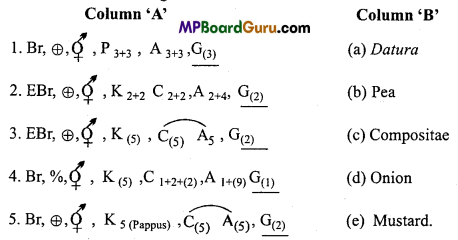
Answer:
1. (d) Onion
2. (e) Mustard
3. (a) Datura
4. (b) Pea
5. (c) Composite
4. Write true or false:
(I) Root, Stem And Leaves
1. Radish is an example of phylloclade.
Answer:
False
2. Nepenthes (Pitcher plant) is an example of carnivorous plant.
Answer:
True
![]()
3. Casparian strips are found in epidermis.
Answer:
False
4. Secondary growth results in the growth of the girth of the plant and not in the length only.
Answer:
True
5. Scleroids and fibres are the components ofXylem tissue.
Answer:
False
(II) FLOWER
1. An inflorescence which contains gall flower is hypanthodium.
Answer:
True.
2. Water is not necessary for fertilization in Vallisnaria plant.
Answer:
False
3. The protein storing layer of endosperm is called aril.
Answer:
True.
4. The inflorescence of compositae is spike.
Answer:
False
5. Caryopsis fruits are found in family Graminae.
Answer:
True.
(III) PLANT FAMILIES
1. Perianth means calyx and corolla are present.
Answer:
False
2. Botanical name of Cabbage is Brassica rapa.
Answer:
False
![]()
3. Replum is characteristic feature of family Cruciferae.
Answer:
True
4. Family Graminae and Cruciferae belong to monocotyledons.
Answer:
False
5. Caryopsis fruits are found in family Cruciferae.
Answer:
False
5. Answer in one word:
(I) Root, Stem And Leaves
1. Tuber of potato is modified.
Answer:
Stem
2. Stem which is green and leaf like is called.
Answer:
Phylloclade
3. In Opuntia, spines are modified.
Answer:
Leaves
4. The function of prop roots of Banyan is.
Answer:
To provide support
5. In aerial stems food is stored in.
Answer:
Swollen roots
6. Name one negatively phototropic organ of the plant.
Answer:
Root
7. The structure that develops from plumule of the germinating seed.
Answer:
Stem
![]()
8. Phylloclade of single intemode is.
Answer:
Cladode
9. Name of one nitrogen fixing bacteria.
Answer:
Rhizobium
10. Give the example of assimilatory root.
Answer:
Trapa
11. Write the example of respiratory root.
Answer:
Jussiaea
12. Which plants have reticulate venation ?
Answer:
Dicot leaves.
(II) FLOWER
1. Largest flower of the world is.
Answer:
Rafflesia
2. Spadix inflorescence is found in.
Answer:
Banana
3. The endosperm in angiospermic plant is.
Answer:
Triploid
![]()
4. Monosporic and nucleate embryo sac is referred as.
Answer:
Polygonum type
5. The edible part of cauliflower is.
Answer:
Inflorescence
6. Which type of inflorescence found in Tulsi?
Answer:
Verticillaster inflorescence
7. Which type of corolla is found in Mustard?
Answer:
Crossed or Cruciform
(III) PLANT FAMILIES
1. Corolla arranged in the form of a cross in family.
Answer:
Cruciferae
2. Rice, Wheat, Maize etc. belong to family.
Answer:
Poaceae
3. Oblique ovary is found in family.
Answer:
Solanaceae
![]()
4. Spike of spikelet type of inflorescence is found in family.
Answer:
Poaceae
5. Type of fruits usually found in Cruciferae family.
Answer:
Siliqua
6. Write the botanical name of Tomato.
Answer:
Lycopersicum esculentum